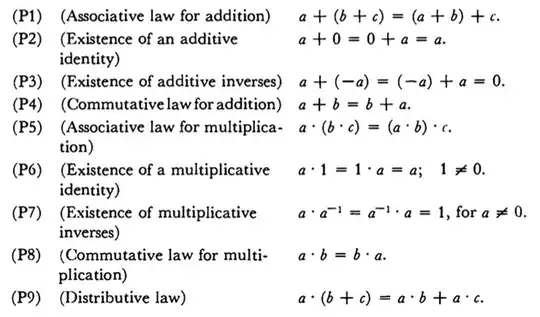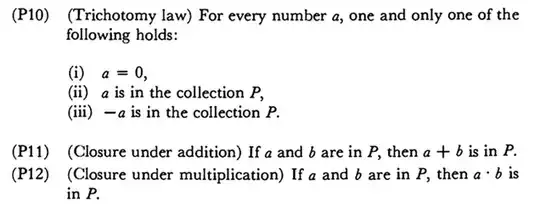If you're planning to do a proof by induction, the first step is to write down your inductive hypothesis, typically expressed as a proposition like "$P(n): (x^n - y^n) = (x-y) \sum_{i=0}^{n-1} x^i y ^ {n-1-i}$.
You then establish the truth of $P(0)$ or $P(1)$ or some other useful starting point. Then you say "Suppose that $P(1), P(2), \ldots, P(k)$ are all true. We will show $P(k+1)$, which states that [write out details here]." And that's the point at which YOUR proof started. But there's not much you can do because you don't have $P(1)$ and $P(2)$ and so on written down. In fact, you probably only need $P(n-1)$ and a few axioms to prove $P(n)$.
But "and so on" arguments like yours are exactly hidden inductions, so your proof is really not a solution to the problem given.
Much as I love Spivak's Calculus, this is one of the pedagogically worst problems in the book in my opinion. Part fo the difficulty is that powers haven't been defined, and the statement isn't true when either $x$ or $y$ is zero and $n = 0$, because $0^0$ is undefined. Setting all that aside, and agreeing that the claim applies to all nonzero $x$ and $y$, and that for these, $x^0 = 1$, let's go ahead and write out a proof.
Before I can do that proof, I need a lemma, also proved by induction:
For any $n \ge 1$, and any nonzero $x$ and $y$, and any $s$, $$
s\sum_{i=0}^n x^i y^{n-1-i} = \sum_{i=0}^n s (x^i y^{n-1-i}).
$$
I might even write out a proof of this down below, but for now, let's run with it.
To show: for every positive integer $n$, and for all nonzero $x$ and $y$ the statement
$P(n): (x^n - y^n) = (x-y) \sum_{i=0}^{n-1} x^i y ^ {n-1-i}$
is true.
Proof:
Step one: base case.
For $n = 1$, the statement asserts that
$(x^1 - y^1) = (x-y)(x^0y^0)$. We must show this is true.
Since for any nonzero number $a$, $a^0 = 1$, we can rewrite $P(1)$ as
\begin{align}
(x^1 - y^1) &= (x-y)(1\cdot 1)
\end{align}
To prove this statement, let's start with the right had side and convert it to the left hand side:
\begin{align}
(x-y)(1 \cdot 1) &= (x-y) \cdot 1, & \text{because of P6, applied to $a = 1$} \\
&= (x-y), & \text{because of P6, applied to $a = 1$}.
\end{align}
Thus the right hand side is equal to the left hand side, and we've established $P(1)$.
Step two: inductive step (following @BrebiusB.Brebs's approach)
We assume for some $k \ge 1$ that $P(k)$ is true, i.e., that
$$x^k - y^k = (x-y) \sum_{i=0}^{k-1} x^i y ^ {k-1-i}$$
for all nonzero $x$ and $y$.
Using this hypotheses, we will prove $P(k+1)$ is true, i.e., that
$$x^{k+1} - y^{k+1} = (x-y) \sum_{i=0}^{k} x^i y ^ {k-i}$$
for all nonzero $x$ and $y$.
To do this, let $x$ and $y$ be any two fixed nonzero values. Let's gradually alter the right hand side of the displayed equation above in an attempt to turn it into the left hand side. For each step on the left, I'll provide a reason on the right.
\begin{align}
(x-y) \sum_{i=0}^{k} x^i y ^ {k-i}
&= \sum_{i=0}^{k} (x-y) (x^i y ^ {k-i}), & \text{Lemma applied to $s = (x-y)$}\\
&= \left(\sum_{i=0}^{k-1} (x-y) (x^i y ^ {k-i}) \right) + (x-y)(x^k y^{k-k}), & \text{The sum from 0 to $k$ is the sum from $0$ to $k-1$ plus the $k$th term; this is a hidden definition of the summation symbol}\\
&= \left(\sum_{i=0}^{k-1} (x-y) (x^i y ^ {k-i}) \right) + (x-y)(x^k y^{0}), & \text{P3, definition of subtraction}\\
&= \left(\sum_{i=0}^{k-1} (x-y) (x^i y ^ {k-i}) \right) + (x-y)(x^k \cdot 1), & \text{$y^0 = 1$ because $y$ is nonzero. }\\
&= \left(\sum_{i=0}^{k-1} (x-y) (x^i y ^ {k-i}) \right) + (x-y)(x^k), & \text{P6 applied to last product }\\
&= \left(\sum_{i=0}^{k-1} (x-y) (x^i (y \cdot y ^ {(k-i) - 1}) \right) + (x-y)(x^k), & \text{Property of exponents: $y^a \cdot y^b = y^(a+b)$, which also must be proved by induction! }\\
&= \left(\sum_{i=0}^{k-1} (x-y) (x^i (y \cdot y ^ { ((k+ (-i)) + (- 1)}) \right) + (x-y)(x^k), & \text{Definition of subtraction, twice}\\
&= \left(\sum_{i=0}^{k-1} (x-y) (x^i (y \cdot y ^ { ((k+ (-1)) + (- i)}) \right) + (x-y)(x^k), & \text{P1, applied within exponent}\\
&= \left(\sum_{i=0}^{k-1} (x-y) (x^i (y \cdot y ^ { (k -1) - i)}) \right) + (x-y)(x^k), & \text{Definition of subtraction}\\
&= \left(\sum_{i=0}^{k-1} (x-y) (x^i y) ( y ^ { (k -1) - i)}) \right) + (x-y)(x^k), & \text{P5, applied within summation -- which is another hidden induction!}\\
&= \left(\sum_{i=0}^{k-1} (x-y) (y x^i) ( y ^ { (k -1) - i)}) \right) + (x-y)(x^k), & \text{P8, applied within summation -- which is another hidden induction!}\\
&= \left(\sum_{i=0}^{k-1} ((x-y) y) x^i ( y ^ { (k -1) - i)}) \right) + (x-y)(x^k), & \text{P5, again induction}\\
&= ((x-y)y)\left(\sum_{i=0}^{k-1} x^i ( y ^ { (k -1) - i)}) \right) + (x-y)(x^k), & \text{Lemma,applied to $s = (x-y)y$}\\
&= (y(x-y))\left(\sum_{i=0}^{k-1} x^i ( y ^ { (k -1) - i)}) \right) + (x-y)(x^k), & \text{P8}\\
&= y\cdot \left( (x-y))\sum_{i=0}^{k-1} x^i ( y ^ { (k -1) - i)}) \right) + (x-y)(x^k), & \text{P5}\\
&= y\cdot \left(x^k - y^k\right) + (x-y)(x^k), & \text{Inductive hypothesis, applied to middle summation}\\
&= (y\cdot x^k - y \cdot y^k) + (x\cdot x^k -y \cdot x^k), & \text{P9, twice ,with the definition of subtraction used as well. }\\
&= (y\cdot x^k + (- y) \cdot y^k) + (x\cdot x^k + (-y) \cdot x^k), & \text{Defn of subtraction, twice }\\
&= ((-y) \cdot y^k + y\cdot x^k ) + x^{k+1}) + (-y) \cdot x^k)), & \text{P4, definition of exponentiation }\\
&= ((-y) \cdot y^k + (y\cdot x^k + x^{k+1})) + (-y) \cdot x^k)), & \text{P1}\\
&= (((-y) \cdot y^k + x^{k+1}) +y\cdot x^k)) + (-y) \cdot x^k)), & \text{P1}\\
&= ((-y) \cdot y^k + x^{k+1}) +(y\cdot x^k + (-y) \cdot x^k), & \text{P1}\\
&= ((-y) \cdot y^k + x^{k+1}) +((y+ (-y)) \cdot x^k), & \text{P9}\\
&= ((-y) \cdot y^k + x^{k+1}) +(0 \cdot x^k), & \text{P3}\\
&= ((-y) \cdot y^k + x^{k+1}) +0, & \text{Lemma to be proved: $0 \cdot a = 0$ for every $a$}\\
&= (x^{k+1} + (-y) \cdot y^k ) , & \text{P4, P2}\\
&= (x^{k+1} + (-1\cdot y) \cdot y^k ) , & \text{Lemma to be proved: $-1 \cdot a = -a$ for any $a$. }\\
&= (x^{k+1} + (-1)\cdot (y \cdot y^k ) , & \text{P5}\\
&= (x^{k+1} + (-1)\cdot (y^{k+1} ) , & \text{Defn of exponent, P4 (to turn $ 1+k$ into $k+1$)}\\
&= (x^{k+1} + (-y^{k+1} ) , & \text{Most recent to-be-proved lemma again}\\
&= x^{k+1} -y^{k+1} , & \text{Def of subtraction}.
\end{align}
And with this (once we prove all those hidden lemmas!) we've proved that $P(k+1)$ is true.
(I apologize: I've got some spare parens dangling around in that mess, and I don't have the heart to go back and find/fix every one of them...)
Now, presumably, you see why I thin this is one of Spivak's worst exercises. The inductive definition of the summation symbol hasn't been given, and nor has the definition of exponentation for real numbers and nonnegative integer exponents, nor have properties like $a^{n+m} = a^n \cdot a^m$ been proved. It's just a plain old pain in the neck. On the other hand, it shows that you CAN do this stuff, and that once you've taken one algebraic manipulation and written it out this way, you (a) never want to do it again, and (b) are confident that you CAN do it agin if called on to do so.

